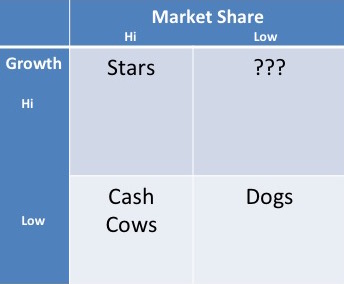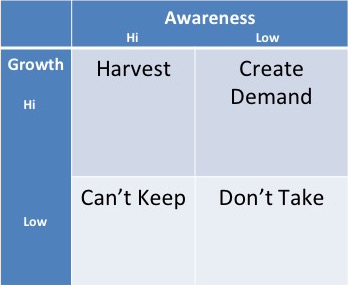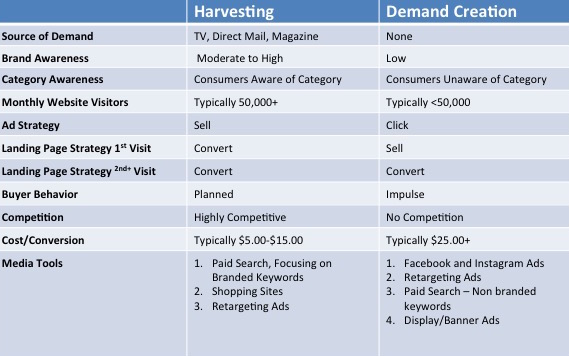A New Twist on the BCG Matrix to Evaluate and Grow Brands Online
A New Twist on the BCG Matrix to Evaluate and Grow Brands Online
A Simple Heuristic for Online Marketing Strategy with Deep Implications
As you probably remember from your Marketing 101 textbook, the BCG Matrix plots a brand’s growth vs. its market share. This has traditionally provided valuable insights that can guide overall brand strategy. SmartClick has turned the venerable BCG matrix on its ear. We’re using it as a heuristic tool to guide online marketing strategies for new clients. We’ll take you through how we create these strategies which differ wildly, depending on if a brand has a high or a low market share within the category.
The BCG Matrix
The BCG matrix is an excellent tool to guide brand strategy, plotting a brand’s rate of growth vs. its market share. This yields 4 cells to which we can categorize brands: stars, cash cows, ???, and dogs.

Stars – If a brand is currently growing very quickly and has a high market share, they’re what we would call a star. You would typically want to feed that star brand with as much working capital as you can to maximize growth and optimize profitability.
Cash Cows – If a brand has high market share, but low growth, they’re a cash cow. They’re typically generating wads of cash, though their profitability is only increasing at a slow rate. The goal is simply to milk as much growth as possible out of the brand, although that can be extremely challenging. There’s often a ceiling involved where incremental spending just isn’t profitable.
??? – If a brand is high growth, but low market share, they’re what we would call a question mark— often early stage brands who are growing quickly but have very low awareness. We often don’t know what the ceiling is with a brand like this, which seems to be responding well to marketing investment and could develop into a star or cash cow. The strategy with question marks is to steadily add budget and programs to experiment and see what the potential is for the brand.
Dogs – If a brand is not growing quickly and they have a low market share, it’s likely the brand is either ineptly marketed, or is just a bad brand. In either case, it’s typically a turnaround situation, with desperate investors and clients, with low profitability, and a reluctance to invest.
The SmartClick Online Marketing Strategy
At SmartClick, we’ve found that by applying the BCG Matrix to client brands, we can develop a quick idea of where our advertising strategy should start.

Harvest – A brand that’s currently growing very quickly and has a high market share, a star, is a dream client. We’ve taken on a number of clients who were already stars. We made them grow more quickly and as a result, take more market share. Typically, we accelerate growth by “plugging holes” in the marketing funnel, often by winning revenue that would otherwise be taken by competitors, compressing purchase frequency, or bringing “ambient awareness” to threshold levels for consumers on the bubble to purchase.
Can’t Keep – A brand exhibiting high market share but low growth, a cash cow, is typically not a great candidate for SmartClick. They’ve often already hit a growth and market share ceiling and are looking for a silver bullet idea to grow—either a dramatic repositioning, new product news, or some other discontinuous innovation. Even when presented with that silver bullet, cash cow brands often don’t have the will to go after it. We’ve taken a number of cash cow clients over the years, but typically these are the clients who hire us to set them up and then “surprise” hire someone in-house to manage campaigns day to day. We’ve even had cash cow clients who take day to day campaign management and creative in-house, tank sales, and then engage us to rescue their brand… again.
Create Demand – A brand that is achieving high growth, but still has low market share— a ??? brand— might describe the bulk of SmartClick’s clients. We work with a lot of these “Fighter Brands” who have the will and budgets to grow. As we demonstrate good return on investment month after month, budgets increase and growth continues. Many clients don’t hit a ceiling and we see rapid growth and increased market share month after month… for years and years. We’ve even helped a few brands make the jump from ??? to stars—this is one of the most gratifying aspects of working at SmartClick.
Don’t Take – If a brand is not growing quickly and they have a low market share, it’s a dog, and we’ve learned that there’s typically very little we can do to help. We typically don’t take on these clients. Usually dog brands are so worried, and under so much pressure from investors or management to “make something happen” that it’s just going to be a bad experience for everyone. A broken brand simply can’t be fixed by some deft online campaigns, typically the issues are fundamental—the product or service, the branding, the value proposition— things that online marketing alone can’t fix.
Tactical Plans for Harvesting vs. Demand Creation
By looking at clients through the BCG Matrix lens, we’ve realized that all of our clients are either stars or ???’s. As a result all of the marketing plans we develop and execute are either Harvesting or Demand Creation plans. Often they’re an amalgam of the two.
As you might imagine, just as there are great differences in how you would develop a plan for a star vs. a ??? in the offline media world, plans for the online media world differ wildly based on a brand’s situation.
We’ve captured how we evaluate and create a plan for both types below:

Source of Demand – First, we must assess the brand’s current source of demand. If a star brand is in harvesting mode, chances are they’re already driving significant offline demand, either from TV, direct mail, magazines, or something else. If a ??? brand isn’t already advertising offline, they simply haven’t reached a stage where TV, direct mail or magazines are affordable, so there’s typically little latent demand already existing.
Brand Awareness – A star brand is already driving a lot of demand. They’re clearly going to have some significant consumer awareness already built up—even if that’s just 5%, that can be enough to at least have some component of the plan be focused on harvesting. Typically, with little offline media already running, a ??? brand will have little to no brand awareness to harvest. As a result, creating demand becomes the key priority.
Category Awareness – Even if a star brand has relatively low awareness, it can likely harvest quite a bit of demand if the category is one that consumers are already familiar with, already searching on, or already talking about on social media. A ??? brand may be creating an entirely new category, typically one that nobody is searching for, so advertising on search engines would make no sense.
Monthly Website Visitors – A star brand typically has 50,000 to several million website visitors each month. With that many visitors, a plan simply focusing on branded keywords and retargeting could generate millions in incremental sales. A ??? brand typically sees fewer than 50,000 monthly visitors, and as a result, we need to create visits to drive sales or leads.
Ad Strategy – The ad strategy for a star brand is to sell. The ad strategy for a ??? brand is typically to get high quality clicks. This engages the right people. However, since it’s often a brand category they’ve never heard of or knew they needed, we rely on the landing pages to do the hard sell.
Landing Page Strategy – The landing page strategy for star brands is to get the conversion, plain and simple. For a ??? brand, the first visit is devoted to selling the consumer. Subsequent visits from retargeting ads using effective landing pages generally lead to the real conversions. As a result, the series of landing pages you design, as well as the order and frequency that you show them will be extremely important to ultimately nurturing and maximizing conversions.
Buyer Behavior – A star brand is trying to exploit planned behavior of a consumer who already knows the category, and likely the brand. Often, star brands are already familiar with their consumers’ behaviors allowing us to focus on the key targeting characteristics of their audience. A ??? brand might not know who their consumer truly is or what their buying behaviors consist of. In this case, we create a plan that focuses on first figuring out the best audience or audiences for the brand, then honing our ads to speak directly to that consumer.
Competition – A star brand often faces massive competition, and as a result, ad and media strategy need to be focused on the chinks in the competitive set’s armor. For a ??? brand, often the competition is indirect, and so the category and brand are able to focus on creating and nurturing awareness and demand with little competition.
Cost/Conversion – If a star brand is harvesting, conversions will be relatively inexpensive, often just $5 or less. For a ??? brand defining or trying to break into a category, it would be unrealistic to expect a cost/conversion of less than $25 initially, although we can often quickly manage that down to be a lot lower.
Media Tools – For star brands, we usually utilize paid search, focusing on branded keywords. Shopping sites, and retargeting ads are typically very fruitful avenues as well. For a ??? brand, Facebook and Instagram ads, retargeting ads, paid search on non-branded keywords, and display/banner ads will combine to create some nice early demand for the brand.
As you can see, there are huge differences in the tactics we execute, depending on the brand’s situation. If we’re harvesting, it’s one set of tactics, if we’re creating demand, it’s an entirely other set of media tactics. We’re experts at both planning and executing strong online marketing plans. If you’d like some help, feel free to call us at (385) 220-2528 or contact us below.









No Comments